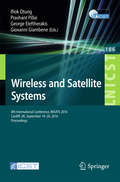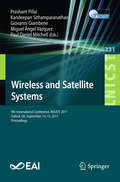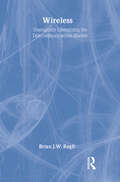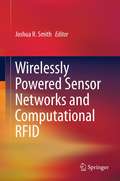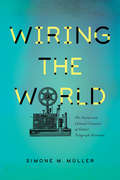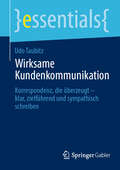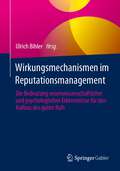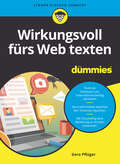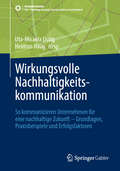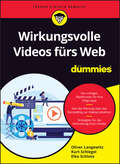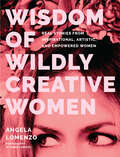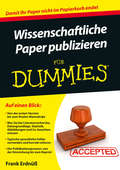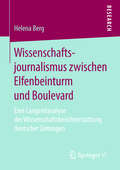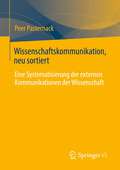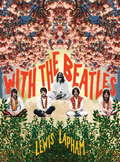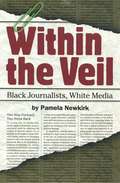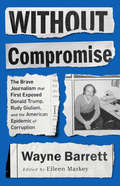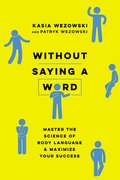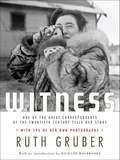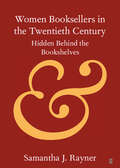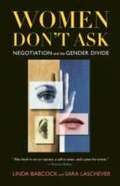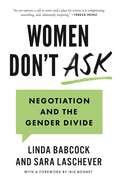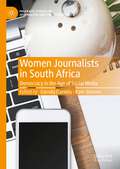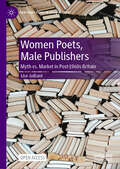- Table View
- List View
Wireless and Satellite Systems
by Giovanni Giambene Prashant Pillai Ifiok Otung George EleftherakisThis book constitutes the proceedings of the 7thInternational Conference on Wireless and Satellite Services, WiSATS 2015, heldin Bradford, UK, in July 2015. The conference was formerly known as theInternational Conference on Personal Satellite Services (PSATS) mainly coveringtopics in the satellite domain. As the scope of the conference widened toinclude wireless systems, the conference was renamed to WiSATS. The 29 revised papers were presented at theconference in three technical sessions and one special session on "Network Codingfor Satellites". WiSATS 2015 also hosted two workshops along with the mainconference: The first workshop, Communication Applications in Smart Grid (CASG2015), focused on the merging area of using communication technology within theelectricity power grid for smart monitoring and control. The second workshop,Advanced Next-Generation Broadband Satellite Systems (BSS 2015), focused on theuse of satellite systems for providing next-generation broadbandservices.
Wireless and Satellite Systems: 8th International Conference, Wisats 2016, Cardiff, Uk, September 19-20, 2016, Revised Selected Papers (Lecture Notes Of The Institute For Computer Sciences, Social-informatics And Telecommunications Engineering Ser. #186)
by Giovanni Giambene Prashant Pillai Kandeepan Sithamparanathan Miguel Ángel Vázquez Paul Daniel MitchellThis book constitutes the proceedings of the 9th International Conference on Wireless and Satellite Services, WiSATS 2017, held in Oxford, UK, in September 2017. The conference was formerly known as the International Conference on Personal Satellite Services (PSATS) mainly covering topics in the satellite domain. The aim of this conference is to bring together researchers, developers and practitioners from around the world in the field of wireless and satellite systems. The theme of WiSATS 2017 was on the means of using the wireless and satellite services directly to the user for personal communications, multimedia and location identification.
Wireless: Strategically Liberalizing the Telecommunications Market (Lea Telecommunications Ser.)
by Brian J.W. RegliThe revolution of wireless communications has only just begun to transform the telecommunications industry worldwide. This book offers insight into the possible options for corporate strategists and government policymakers as they look to harness the expansion of wireless communications to meet the goals of sustainable telecommunications development. Using a multidisciplinary approach which combines policy research, legal analysis, business economics, and models of sustainability from the environmental sciences, the book compares the development of wireless communications in four countries: the United States, the United Kingdom, Russia, and Brazil. The comparative analysis points to common themes and opportunities, including: * breaking down the barriers between wireless and wireline access by changing the regulatory design which constrains service providers; * targeting the development potential of wireless access through the utilization of new technologies and service models; and * using wireless access as the basis for full facilities-based competition in both developing and developed world markets. No other book today offers this broad a context for a discussion of wireless communications and its potential impact on the evolution of the telecommunications industry.
Wirelessly Powered Sensor Networks and Computational RFID
by Joshua R. SmithThe Wireless Identification and Sensing Platform (WISP) is the first of a new class of RF-powered sensing and computing systems. Rather than being powered by batteries, these sensor systems are powered by radio waves that are either deliberately broadcast or ambient. Enabled by ongoing exponential improvements in the energy efficiency of microelectronics, RF-powered sensing and computing is rapidly moving along a trajectory from impossible (in the recent past), to feasible (today), toward practical and commonplace (in the near future). This book is a collection of key papers on RF-powered sensing and computing systems including the WISP. Several of the papers grew out of the WISP Challenge, a program in which Intel Corporation donated WISPs to academic applicants who proposed compelling WISP-based projects. The book also includes papers presented at the first WISP Summit, a workshop held in Berkeley, CA in association with the ACM Sensys conference, as well as other relevant papers. The book provides a window into the fascinating new world of wirelessly powered sensing and computing.
Wiring the World: The Social and Cultural Creation of Global Telegraph Networks (Columbia Studies in International and Global History)
by Simone MüllerThe successful laying of a transatlantic cable in 1866 remade world communications. A message could travel across the ocean in minutes, shrinking the space between continents, cultures, and nations. An eclectic group of engineers, entrepreneurs, politicians, and media visionaries then developed this technology into a telecommunications system that spread a particular vision of civilization—but not everyone wanted to wire the world the same way. Wiring the World is a cultural and social history that explores how the large Anglo-American cable companies won out over alternative visions. Bitter rivalries emerged over telegram prices, visions for world peace, scientific innovation, and the role of the nation-state. Such struggles determined the growth of cable technology, which in turn influenced world history. Filled with fascinating characters and new insights into pivotal events, Wiring the World traces globalization's diverse paths and close ties to business and politics.
Wirksame Kundenkommunikation: Korrespondenz, die überzeugt – klar, zielführend und sympathisch schreiben (essentials)
by Udo TaubitzDieses essential gibt Ihnen das Handwerkszeug für kundenfreundlichen Schreibstil, der sich positiv auf die Kundenbeziehung auswirkt – und Ihr Business nach vorn bringt. Ob Brief, E-Mail oder Newsletter, ob B2B oder B2C: Sie lernen, wie Sie Ihre Message schnell, verständlich und nahbar rüberbringen – und wie Sie lösungsorientiert auf Beschwerden antworten.
Wirkungsmechanismen im Reputationsmanagement: Die Bedeutung neurowissenschaftlicher und psychologischer Erkenntnisse für den Aufbau des guten Rufs
by Ulrich BihlerDieses Buch zeigt aus neuro- und kommunikationswissenschaftlichen sowie psychologischen Perspektiven auf, wie Reputation von Unternehmen, Organisationen, C-Level-Management oder Aufsichtsrat entsteht und erfolgreich gemanagt werden kann.Ihren guten Ruf in der Öffentlichkeit können insbesondere Unternehmen zwar durch die Konsistenz aus Unternehmensrealität und -kommunikation bewirtschaften – aber alleine in den Köpfen der Menschen wird über die Reputation entschieden. Nur wer versteht, wie sie bei Stakeholdern genau entsteht und welche Wirkmechanismen dabei zum Tragen kommen, wird auch künftig erfolgreich als Unternehmen kommunizieren und das öffentliche Urteil über die eigenen Wesenszüge – die Reputation – positiv gestalten. Autorinnen und Autoren aus Wissenschaft und Praxis teilen in diesem Werk ihren Erfahrungs- und Wissensfundus, um Reputation als auslösende Wirkkraft im Gehirn für gewünschtes menschliches Handeln im Sinne von Unternehmen zu erläutern. Die Autorinnen und Autoren liefern ganzheitliche, aber auch überraschende Perspektiven, neue Zusammenhänge und Insights sowie hilfreiche Praxistipps.
Wirkungsvoll fürs Web texten für Dummies (Für Dummies)
by Gero PflugerSie haben eine Website und möchten in Texten Informationen über Produkte oder Dienstleistungen liefern? Sie verkaufen übers Internet und brauchen knackige Produktbeschreibungen? Oder ist Ihr tägliches Brot das Schreiben von Online-Pressemitteilungen, E-Mail-Newslettern oder Social-Media-Beiträgen? Dieses Buch unterstützt Sie dabei, bessere Texte für Ihre Online-Auftritte zu produzieren, damit diese für Ihre Besucher und Follower relevanter werden. Lernen Sie Texten: Es ist gar nicht so schwer.
Wirkungsvolle Nachhaltigkeitskommunikation: So kommunizieren Unternehmen für eine nachhaltige Zukunft – Grundlagen, Praxisbeispiele und Erfolgsfaktoren (SDG - Forschung, Konzepte, Lösungsansätze zur Nachhaltigkeit)
by Heidrun Haug Uta-Micaela DürigDieses Buch erläutert, wie Unternehmen das Thema Nachhaltigkeit mit allen Aspekten wirkungsvoll kommunizieren können, um auch in Zukunft bei allen Stakeholdern relevant und glaubwürdig zu bleiben. Denn Nachhaltigkeitsstrategien sind nicht mehr nice-to-have, sondern überlebenswichtig geworden – auch für Unternehmen. Das Werk schafft mit fundierten Beiträgen ein klares Verständnis von nachhaltiger Entwicklung sowie ihrer Kommunikation und geht unter anderen diesen Fragen nach: Wie kann Führungskräfte-Commitment die nachhaltige Entwicklung bestärken? Wie werden Kommunikationsteams aktive Gestalter nachhaltiger Transformation? Wie sieht ein nachhaltiges Zukunftsnarrativ für Unternehmen aus? Welche Rolle spielen Green Claims? Wie schädlich ist Greenwashing? Wie steht es um den CO2-Fußabdruck von Kommunikation? Und: Welche Unternehmen bieten Best Practices und sind in der Umsetzung ihrer Nachhaltigkeitskommunikation erfolgreich? Ein unverzichtbares Buch für Unternehmenslenker, Verantwortliche der Unternehmenskommunikation, Mitglieder in Stiftungs- und Unternehmensaufsichtsräten, Engagement Manager, Agenturen sowie die Managementlehre und Studierende. Uta-Micaela Dürig ist u.a. Transformations- und Sustainability-Beraterin, Autorin und als Dozentin an Hochschulen tätig. Zuvor war sie über 20 Jahre in Leitungsfunktionen für Unternehmenskommunikation und Nachhaltigkeit in Wirtschaftsunternehmen tätig, u. a. bei ABB und RWE. Bei Bosch war sie als Leiterin der Konzernkommunikation tätig und als Geschäftsführerin der Robert Bosch Stiftung. Seit 01.04.2023 ist sie Vorständin für Sozialpolitik eines freien Wohlfahrtsverbandes in Stuttgart. Heidrun Haug ist Gründerin und geschäftsführende Hauptgesellschafterin der Storymaker Public Relations GmbH in Tübingen sowie Mitgründerin der ResCom Academy GmbH. Zuvor war sie 20 Jahre als Journalistin für Wirtschafts- und Technologiezeitschriften tätig. 2001 hat sie die Kommunikationsagentur mit dem Ziel gegründet, Unternehmen in glaubwürdige und nachhaltige Erfolgsgeschichten zu verwandeln. Die Agentur ist Partner des Weltethos-Instituts der Universität Tübingen, berät Unternehmen bei Nachhaltigkeitskommunikation und hat 2023 eine eigene Klimabilanz erstellt. Sie ist im Advisory Board des Studiengangs Kommunikations- und Medienmanagement der SRH Mobile University und Mitglied im Arbeitskreis MediaPolitics der DPRG.
Wirkungsvolle Videos fürs Web für Dummies (Für Dummies)
by Oliver Langewitz Kurt Schlegel Elke SchloteMithilfe von Videos das Netz begeistern Videos bieten Ihnen die Möglichkeit, eigene Ideen zu vermitteln oder Ihre Marke zu präsentieren. Wie Sie wirkungsvolle Videos fürs Web erstellen und was Sie bei der videobasierten Kommunikation beachten müssen, erfahren Sie in diesem Buch. Oliver Langewitz, Kurt Schlegel und Elke Schlote erklären Ihnen in praktischen Schritten, wie Ihnen die Planung, Erstellung und Verbreitung von Videos fürs Web optimal gelingt. Dabei lernen Sie auch die Besonderheiten der verschiedenen Internetplattformen kennen und wie Sie Ihre Zielgruppe mit Ihren Inhalten abholen. Sie erfahren Wie Sie professionelle Webvideos produzieren Wie Sie in Ihren Videos wirksame Geschichten erzählen Welche Online-Kanäle für Ihre Videos wichtig sind Wie es Ihnen gelingt, mit Ihren Videos eine breite Community zu erreichen
Wisdom of Wildly Creative Women: Real Stories from Inspirational, Artistic, and Empowered Women
by Angela Lomenzo James LomenzoReal Stories from Wildly Creative Women“If you need an extra boost of bravery, read this book! If you want to simply feel more positive about the world, read this book!” —Sherry Richert Belul, founder of Simply Celebrate and author of Say It Now#1 New Release in Interviews, Photography Criticism & Essays, and PhotojournalismAngela LoMenzo combines stunning photography and powerful real stories documented from interviews with a diverse group of accomplished women that encourages us to dig deep into our own creative lives!Women from all walks of life. Artists, musicians, authors, fashion designers, entrepreneurs, and others from a multitude of creative careers share their experiences with depression, bullying, infertility, cancer, assault, loss of loved ones, drug addiction, and many other issues women often do not have a safe space to talk about. These stories show you just how real life is.Powerful affirmations and true-life stories to empower you. This book is packed with words of wisdom from women who have both overcome adversity and achieved an authentic life honoring their individuality and freedom of personal expression. Their real stories illustrate that it is possible to live the life you have always desired now.Inside, you’ll find:Words of wisdom and beautiful photography of wildly creative womenRaw and authentic interviews featuring stories by women redefining the role of a womanAnd much more!If you're looking for unique gifts for women who have everything or if you like books such as Women, In the Company of Women, Collective Wisdom, or A Room of Her Own, you need to read Wisdom of Wildly Creative Women!
Wissenschaftliche Paper publizieren für Dummies
by Frank ErdnüßEs ist soweit: Sie haben endlose Zeit im Labor, Feld oder über Literaturbergen verbracht und nun ist es an der Zeit, Ihre Erkenntnisse der wissenschaftlichen Gemeinschaft mitzuteilen; kurzum Sie müssen oder wollen in einer Fachzeitschrift publizieren. Dabei gibt es einiges zu beachten und meist ist die Zeit auch noch knapp. Aber keine Sorge, Frank Erdnüß hat für Sie kurz alles Wichtige zusammengestellt, was es bei einer wissenschaftlichen Veröffentlichung zu beachten gibt. Egal ob es Ihr erstes Paper ist oder ob Sie schon Publikationserfahrung haben; Sie erhalten Tipps zur Auswahl des richtigen Journals, zu Statistik, Literaturverwaltung, Grafiken, Zitierweisen, Wissenschaftsenglisch und vielem mehr. Dieses praxisnahe Buch begleitet Sie über die gesamte Manuskripterstellung und den Publikationsprozess hinweg, bis es schließlich heißt: Paper accepted.
Wissenschaftsjournalismus zwischen Elfenbeinturm und Boulevard: Eine Langzeitanalyse Der Wissenschaftsberichterstattung Deutscher Zeitungen
by Helena BergHelena Berg beschäftigt sich mit der Frage nach Boulevardisierungstendenzen in der Wissenschaftsberichterstattung deutscher überregionaler Qualitätszeitungen. Basierend auf einer Inhaltsanalyse im Zeitraum von 1995 bis einschließlich 2014 untersucht die Autorin Veränderungen der Berichterstattung im Hinblick auf zentrale gestalterische, inhaltliche und sprachliche Merkmale des Boulevardjournalismus. Dabei stellt sie Gemeinsamkeiten und Unterschiede in der Entwicklung der fünf analysierten Zeitungen heraus und nimmt eine differenzierte Betrachtung des Zusammenhangs von Boulevardisierungsprozessen und journalistischer Qualität vor.
Wissenschaftskommunikation, neu sortiert: Eine Systematisierung der externen Kommunikationen der Wissenschaft
by Peer PasternackDer Ausgangspunkt dieser Neusortierung ist: Wissenschaftskommunikation ist die Kontaktaufnahme und -pflege der Wissenschaft mit der Nichtwissenschaft, also mit ihrer Umwelt. Damit wird das Verständnis von Wissenschaftskommunikation sowohl eingeschränkt als auch erweitert: eingeschränkt auf die externe Kommunikation der Wissenschaft, erweitert auf jegliche Kontaktaufnahmen und -pflege der Wissenschaft mit der Nichtwissenschaft.Es zeigt sich, dass es sehr viel mehr Wissenschaftskommunikation gibt, als man gemeinhin denkt, darunter zahlreiche Varianten, die noch gar nicht als Wissenschaftskommunikation erkannt werden. Zugleich zeigt sich: Gemessen an der Verarbeitbarkeit der Angebote findet zu viel Wissenschaftskommunikation statt, und gemessen an der Wirksamkeit der Angebote findet zu wenig effektive, d. h. zielerreichende Wissenschaftskommunikation statt. Um das zu ändern, bedarf es eines deutlichen Bildes davon, was Wissenschaftskommunikation ist, wie sie von anderen Kommunikationen abgegrenzt ist und wie sie intern differenziert ist. Dieses Bild wird hier gezeichnet.
With the Beatles
by Lewis LaphamHalfway between the summer of love and the Tet offensive, the Beatles went to India to study with the Maharishi--and Lewis Lapham, esteemed Harper's editor and award-winning writer, was there. WITH THE BEATLES is a remarkable book of cultural commentary on that seminal '60s moment.The ashram in Rishikesh, India was the ultimate '60s scene: the Beatles, Donovan, Mia Farrow, a stray Beach Boy and other '60s icons gathered along the shores of the Ganges--amidst paisley and incense and flowers and guitars--to meditate at the feet of the Maharishi Mahesh Yogi. The February 1968 gathering received such frenzied, world-wide attention that it is still considered a significant, early encounter between Western pop culture and the mystical East. And Lewis Lapham was the only journalist allowed inside.And what went on inside the compound has long been the subject of wild speculation and rampant rumor. The Beatles said they wrote some of their greatest songs there . . . and yet they also came away bitterly disillusioned. In WITH THE BEATLES, Lewis Lapham finally tells the whole story.
Within the Veil: Black Journalists, White Media
by Pamela NewkirkWinner of the National Press Club Prize for Media CriticismUnmasks race-related conflicts in the newsrooms and the push for more equitable coverage of racial minorities Thirty years ago, the Kerner Commission Report made national headlines by exposing the consistently biased coverage afforded African Americans in the mainstream media. While the report acted as a much ballyhooed wake-up call, the problems it identified have stubbornly persisted, despite the infusion of black and other racial minority journalists into the newsroom. In Within the Veil, Pamela Newkirk unmasks the ways in which race continues to influence reportage, both overtly and covertly. Newkirk charts a series of race-related conflicts at news organizations across the country, illustrating how African American journalists have influenced and been denied influence to the content, presentation, and very nature of news. Through anecdotes culled from interviews with over 100 broadcast and print journalists, Newkirk exposes the trials and triumphs of African American journalists as they struggle in pursuit of more equitable coverage of racial minorities. She illuminates the agonizing dilemmas they face when writing stories critical of blacks, stories which force them to choose between journalistic integrity, their own advancement, and the almost certain enmity of the black community. Within the Veil is a gripping front-line report on the continuing battle to integrate America's newsrooms and news coverage.Companion website: http://www.nyupress.nyu.edu/authors/veil.html
Without Compromise: The Brave Journalism that First Exposed Donald Trump, Rudy Giuliani, and the American Epidemic of Corruption
by Wayne BarrettA collection of groundbreaking investigations by Wayne Barrett, the intrepid, muckraking Village Voice journalist who exposed corruption in New York City and beyond.With piercing moral clarity and exacting rigor, Wayne Barrett tracked political corruption in the pages of the Village Voice fact by fact, document by document for 40 years. The first to report on the scams and crooked deals that fueled the rise of Donald Trump in 1979, Barrett went on to expose the shady dealings of small-time slum lords and powerful New York City politicians alike, from Ed Koch to Rudy Giuliani to Michael Bloomberg.Without Compromise is the first anthology of Barrett's investigative work, accompanied by essays from colleagues and those he trained. In an age of lies, fog, and propaganda, when the profession of journalism is degraded by the White House and the industry is under financial threat, Barrett reminds us that facts, when clearly accumulated, are our best defense of democracy.Featuring essays by:Joe ConasonKim Phillips-FeinErrol LouisGerson BorreroTom RobbinsTracie McMillanPeter NoelAdam FifieldJarrett MurphyAndrea BernsteinJennifer GonnermanMac Barrett
Without Saying a Word: Master the Science of Body Language and Maximize Your Success
by Kasia Wezowski Patryk WezowskiOne wrong move can undercut your message. Believe it or not, our bodies speak louder than our words.Postures, gestures, and expressions convey reams of information—and often not what you&’d expect. A smile, for example, is usually considered welcoming. However, crook one corner of your mouth higher and you project superiority, subconsciously chasing other people away.This book explains how even the subtlest motions have meaning. Distilling decades of research, Without Saying a Word deciphers these unspoken signals:facial expressions,fleeting micro expressions,positive body language,negative body language,And much more!Discover which postures and gestures indicate confidence and build rapport—and which reveal disinterest, arrogance, or even aggression. Learn to end off-putting habits, accentuate good ones, and become an authentic and effective communicator.Exhibiting body language that is open, honest, and self-assured increases your social influence and enhances your skill as a negotiator while the ability to read the emotions and intentions of others is equally indispensable. Whether you&’re making a presentation, pitching a project, or closing a deal, the right body language can be your best ally.
Witness: One of the Great Foreign Correspondents of the Twentieth Century Tells Her Story
by Ruth GruberWith her perfect memory (and plenty of zip), ninety-five-year-old Ruth Gruber--adventurer, international correspondent, photographer, maker of (and witness to) history, responsible for rescuing hundreds of thousands of Jewish refugees during World War II and after--tells her story in her own words and photographs. Gruber's life has been extraordinary and extraordinarily heroic. She received a B.A. from New York University in three years, a master's degree from the University of Wisconsin a year later, and a Ph.D. from the University of Cologne (magna cum laude) one year after that, becoming at age twenty the youngest Ph.D. in the world (it made headlines in The New York Times; the subject of her thesis: the then little-known Virginia Woolf). At twenty-four, Gruber became an international correspondent for the New York Herald Tribune and traveled across the Soviet Arctic, scooping the world and witnessing, firsthand, the building of cities in the Siberian gulag by the pioneers and prisoners Stalin didn't execute... At thirty, she traveled to Alaska for Harold L. Ickes, FDR's secretary of the interior, to look into homesteading for G.I.s after World War II... And when she was thirty-three, Ickes assigned another secret mission to her--one that transformed her life: Gruber escorted 1,000 Holocaust survivors from Italy to America, the only Jews given refuge in this country during the war. "I have a theory," Gruber said, "that even though we're born Jews, there is a moment in our lives when we become Jews. On that ship, I became a Jew." Gruber's role as rescuer of Jews was just beginning. In Witness, Gruber writes about what she saw and shows us, through her haunting and life-affirming photographs-- taken on each of her assignments-- the worlds, the people, the landscapes, the courage, the hope, the life she witnessed up close and firsthand: the Siberian gulag of the 1930s and the new cities being built there (Gruber, then untrained as a photographer, brought her first Rolleicord with her)... the Alaska highway of 1943, built by 11,000 soldiers, mostly black men from the South (the highway went from Dawson Creek, British Columbia, 1,500 miles to Fairbanks)... her thirteen-day voyage on the army-troop transport Henry Gibbins with refugees and wounded American soldiers, escorting and then photographing the refugees as they arrived in Oswego, New York (they arrived in upstate New York as Adolf Eichmann was sending 750,000 Jews from Hungary to Auschwitz). In 1947, Gruber traveled for the Herald Tribune with the United Nations Special Commission on Palestine (UNSCOP) through the postwar displaced persons camps in Europe, and then to North Africa, Palestine, and the Arab world; the committee's recommendation that Palestine be partitioned into a Jewish state and an Arab state was one of the key factors that led to the founding of Israel. We see Gruber's remarkable photographs of a former American pleasure boat (which had been renamed Exodus 1947) as it limped into Haifa harbor, trying to deliver 4,500 Jewish refugees (including 600 orphans), under attack by five British destroyers and a cruiser that stormed the Exodus with guns, tear gas, and truncheons, while the crew of the Exodus fought back with potatoes, sticks, and cans of kosher meat. In a cable to the Herald Tribune, Gruber reported that "the ship looks like a matchbox splintered by a nutcracker." She was with the people of the Exodus and photographed them when they were herded onto three prison ships. Gruber represented the entire American press aboard the ship Runnymede Park, photographing the prisoners as they defiantly painted a swastika on the Union Jack. During her thirty-two years as a correspondent, Ruth Gruber photographed what she saw and captured the triumph of the human spirit. "Take photographs with your heart," Edward Steichen told her. Witness is a revelation--of a time, a place, a world, a spirit, a belief. It is, above all else, a book of heart.
Women Booksellers in the Twentieth Century: Hidden Behind the Bookshelves (Elements in Publishing and Book Culture)
by Samantha J. RaynerThe British women booksellers who built and ran successful businesses before, during, and after the Second World War have largely been forgotten. This Element seeks to reclaim some of these histories from where they lie hidden or obscured in archives, accounts of the book trade of the time, and other sources. Though they were often called 'formidable', this research reveals astonishing impact at local, national, and international levels. Divided into four main sections, the Element first gives a literature review of materials about booksellers, before giving a short context to bookselling, the book trade, and book buyers and readers of the early twentieth century. A third section examines the position of women in society at that time, including how they were viewed as part of the book trade; the final section provides histories of nine women booksellers. This title is also available as Open Access on Cambridge Core.
Women Don't Ask
by Linda Babcock Sara LascheverWhen Linda Babcock asked why so many male graduate students were teaching their own courses and most female students were assigned as assistants, her dean said: "More men ask. The women just don't ask." It turns out that whether they want higher salaries or more help at home, women often find it hard to ask. Sometimes they don't know that change is possible--they don't know that they can ask. Sometimes they fear that asking may damage a relationship. And sometimes they don't ask because they've learned that society can react badly to women asserting their own needs and desires. By looking at the barriers holding women back and the social forces constraining them, Women Don't Ask shows women how to reframe their interactions and more accurately evaluate their opportunities. It teaches them how to ask for what they want in ways that feel comfortable and possible, taking into account the impact of asking on their relationships. And it teaches all of us how to recognize the ways in which our institutions, child-rearing practices, and unspoken assumptions perpetuate inequalities--inequalities that are not only fundamentally unfair but also inefficient and economically unsound. With women's progress toward full economic and social equality stalled, women's lives becoming increasingly complex, and the structures of businesses changing, the ability to negotiate is no longer a luxury but a necessity. Drawing on research in psychology, sociology, economics, and organizational behavior as well as dozens of interviews with men and women from all walks of life, Women Don't Ask is the first book to identify the dramatic difference between men and women in their propensity to negotiate for what they want. It tells women how to ask, and why they should.
Women Don't Ask: Negotiation and the Gender Divide
by Linda Babcock Sara LascheverWhen Linda Babcock asked why so many male graduate students were teaching their own courses and most female students were assigned as assistants, her dean said: "More men ask. The women just don't ask." It turns out that whether they want higher salaries or more help at home, women often find it hard to ask. Sometimes they don't know that change is possible--they don't know that they can ask. Sometimes they fear that asking may damage a relationship. And sometimes they don't ask because they've learned that society can react badly to women asserting their own needs and desires. By looking at the barriers holding women back and the social forces constraining them, Women Don't Ask shows women how to reframe their interactions and more accurately evaluate their opportunities. It teaches them how to ask for what they want in ways that feel comfortable and possible, taking into account the impact of asking on their relationships. And it teaches all of us how to recognize the ways in which our institutions, child-rearing practices, and unspoken assumptions perpetuate inequalities--inequalities that are not only fundamentally unfair but also inefficient and economically unsound. With women's progress toward full economic and social equality stalled, women's lives becoming increasingly complex, and the structures of businesses changing, the ability to negotiate is no longer a luxury but a necessity. Drawing on research in psychology, sociology, economics, and organizational behavior as well as dozens of interviews with men and women from all walks of life, Women Don't Ask is the first book to identify the dramatic difference between men and women in their propensity to negotiate for what they want. It tells women how to ask, and why they should.
Women Don't Ask: Negotiation and the Gender Divide
by Linda Babcock Sara LascheverThe groundbreaking classic that explores how women can and should negotiate for parity in their workplaces, homes, and beyondWhen Linda Babcock wanted to know why male graduate students were teaching their own courses while female students were always assigned as assistants, her dean said: "More men ask. The women just don't ask." Drawing on psychology, sociology, economics, and organizational behavior as well as dozens of interviews with men and women in different fields and at all stages in their careers, Women Don't Ask explores how our institutions, child-rearing practices, and implicit assumptions discourage women from asking for the opportunities and resources that they have earned and deserve—perpetuating inequalities that are fundamentally unfair and economically unsound. Women Don't Ask tells women how to ask, and why they should.
Women Journalists in South Africa: Democracy in the Age of Social Media (Palgrave Studies in Journalism and the Global South)
by Kate Skinner Glenda DanielsThis edited collection examines women journalists’ experiences and obstacles in South Africa’s (SA) democracy. They exercise power, and add a vital diversity, but they are routinely harassed in the online social media space of big tech companies such as Twitter and Facebook by populist and corrupt politicians and their supporters. Using SA as the case study, this book examines attempts to curb women journalists’ freedom combining theory and first-hand accounts. The target audience for the book includes scholars of political philosophy, gender, media, communications, NGOs, media freedom activists and journalists.
Women Poets, Male Publishers: Myth vs. Market in Post-1960s Britain (New Directions in Book History)
by Lise JaillantWe are often told that the women’s movement of the 1960s and 1970s led to the rediscovery of forgotten women writers. Without feminist presses such as Virago, these women would have sunk into obscurity. Thanks to Carmen Callil and other trailblazing feminist publishers, a canon of women’s literature emerged, and living writers managed to survive and sometimes thrive in a literary marketplace that had so far been dominated by men. Although obstacles remained, the story is one of the triumphs over a misogynistic publishing industry—a sector that had once sought to erase women writers of the past, marginalise living authors, and close the doors to any future legacy. There are two problems with this oft-repeated story. First, it focuses mainly on fiction rather than poetry (founded in 1973, Virago did not start publishing poetry until the early 1980s). Second, it neglects the major role that conservative male publishers played in (re)discovering women poets in post-1960s Britain. With the growing influence of the Women’s Liberation movement, these publishers realised that there was a growing market for poetry by women. At the same time, the Arts Council of Great Britain started pushing for more diversity, nudging its “clients” to make more room for women and ethnic minorities. Drawing on extensive archival work and oral history interviews, this open access book pushes the boundaries of a scholarship that has focused mainly on women’s poetry in relation to women’s presses. Archival documents show the influence of the Arts Council and the market in pushing conservative publishers towards more diversity. This evolution has had long-term consequences on the canon of women’s poetry, a canon that was largely shaped by conservative publishing houses rather than radical feminist presses.
